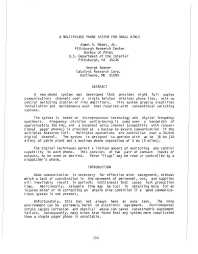Mining Publication: A Multiplexed Phone System for Small Mines
Original creation date: July 1982
A new phone system was developed that provides eight full duplex communications channels over a single twisted shielded phone line, with no central switching station or line amplifiers. This system greatly simplifies installation and maintenance over that required with conventional switching systems. The system is based on microprocessor technology and digital frequency synthesis. Frequency division multiplexing is used over a bandwidth of approximately 300 kHz, and a baseband voice channel (compatible with conventional pager phones) is provided as a backup to assure communication if the multiplex features fail. Multiplex operations are controlled over a 30-kHz digital channel. The system is designed to operate with up to 16 km (10 miles) of cable plant and a maximum phone separation of 8 km (5 miles). The digital techniques permit a limited amount of monitoring and control capability to each phone. This consists of two pair of contact inputs or outputs, to be used as desired. These "flags" may be read or controlled by a dispatcher's phone.
Authors: JR Means, G Bowser
Conference Paper - July 1982
NIOSHTIC2 Number: 20031849
The Sixth WVU Conference on Coal Mine Electrotechnology, Cooley-WL, ed., Morgantown West Virginia, Jul 28-30, 1982, 1982 Nov; :116-123
See Also
- Experience with an Integrated, Computer-Controlled Communications and Monitoring System at the Robena Mine
- Medium-Frequency Propagation in Coal Mines
- Mine Communications and Tracking Glossary
- Research and Development Contract for Coal Mine Communication System: Volume 2 - Mine Visits
- Theory on the Propagation of UHF Radio Waves in Coal Mine Tunnels
- Through-The-Earth Wireless Real-Time Two-Way Voice Communications
- U.S. Bureau of Mines New Developments in Mine Communications
- Ultra-Low Frequency Through-the-Earth Communication Technology
- Underground Mine Communications
- Underground Mine Communications (in Four Parts): 2. Paging Systems
- Page last reviewed: 9/21/2012
- Page last updated: 9/21/2012
- Content source: National Institute for Occupational Safety and Health, Mining Program


 ShareCompartir
ShareCompartir
